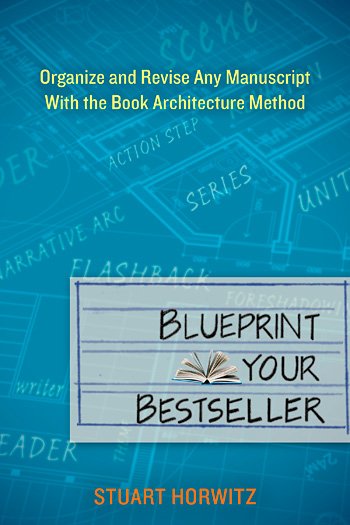
Today’s guest post is by Stuart Horwitz, author of Blueprint Your Bestseller. Find him on Twitter at @Book _Arch.
One thing I hear from writers a lot is, “My work has always been more character-driven, which I think is why I struggle with plot.”
I’m not sure what character-driven means in this context. Does it mean that their work is more about what people think and feel than about the things that happen? Maybe. But it may also simply mean, “I like to write really messy first drafts, and the only way I can find my way through the material at all is by identifying with a character or two.”
But guess what: First drafts are supposed to be a mess! And the notion of “plot” is a misconception that leads too many writers to get confused and focus on all the wrong things. In fact, the best way to produce a first draft is to produce a large pile of pages and avoid trying to organize anything at all. At first.
Upon hearing this, writers may ask, “How do I know when I’ve finished my first draft?” In a sense, first drafts are never finished; where you stopped writing is the end of the first draft. Then it’s time to step back and see what you’ve got. And the way I recommend doing this is by using the unfamiliar, plot-free concept of series.
What is this series I speak of?
A series is the repetition and variation of a narrative element within a story, the process of improvement or deterioration which creates the narrative arc.
The repetitions and variations of an object, for example, is what creates a symbol. A series can also be seen in the repetitions and variations of a person (or if you prefer, their identity and change), which is what creates a character.
Series is how a repeated phrase becomes the work’s philosophy and how a particular setting takes on significance. In short, everything that repeats and varies in your work is a series. But unlike the word “plot”—which basically means everything that seems to be important, all at once—you can work with a series. Once you begin looking, you’ll probably find that there are 10-15 series in your work if you are writing a book-length piece of fiction or nonfiction. When you find them, you can work with them individually first, which makes life much simpler.
Imagine just working with one series at a time. Let’s say you want to introduce 9/11 into your narrative. “Tricky! Overdone!” shouts the voice of the critic. “That must have been so awful for you,” says the voice of a sympathetic cheerleader. But neither of these approaches are particularly helpful. “Let’s wait and see,” says a neutral audience member. “Let’s see how 9/11 is used before we pass any judgment.” And that’s the real key, how something is used, not what it is in the abstract.
The first time you introduce 9/11 is the first iteration in that series. Your readers won’t even really notice it. The first iteration is like planting a seed. You’ve probably heard of the Chekhov saying, “A gun in the first act must go off in the third.” Well, this is the first act.
The second time you mention 9/11 your readers will be more keyed in. They will want to see what is different about the reference to 9/11 this time. That is the second iteration. In this and all following iterations you will want to either change the context and/or the content of how and when you bring up 9/11; that change is how emotion is generated in a narrative.
Thinking about one series at a time can be very helpful when you want to time your iterations as well. If, for example, you mention 9/11 on page 7 and on page 17, and then not again until page 297, you will have created a certain suspense by its absence. Was that your intent or did you just miss an iteration?
Series can also help with beginnings, middles, and ends. My guess is that this series we are discussing (9/11: present on pages 7, 17, and 297) is missing a middle. The “suspense” that has been created is probably because we forgot to fill in several blanks.
Now comes the best part. When you have a bunch of your series relatively clear in your mind, you can lay them out like individual strands of rope. You can entwine them in development, knot them together in conflict, thereby creating a net which ensures the overall work has unity. If you want to call that a plot, go ahead. But plots are awful to write. Like in the human body, the blood, muscle, and tissue all develop before the bone.
If you enjoyed this post, then I encourage you to check out Stuart Horwitz’s newest release, Blueprint Your Bestseller. Click here to view it on Amazon or download a sample to your Kindle.
Stuart Horwitz is the the founder of editorial assistance firm, Book Architecture, and author of three books on writing, including Blueprint Your Bestseller (2013, Penguin/Perigee). He connected with Madison Utley during her first ghostwriting project and it was in answering her questions and helping guide her entry into the industry that Stuart realized the dearth of information readily available about how to become an independent editor. Over time, the pair’s conversations morphed into the Independent Editor Podcast. Have specific questions we didn’t answer in Season One? Email us and let us know what topics you’d like covered in Season Two!


Stuart, I’ve read a few of your other blog posts and picked up a copy of your book, and I have to admit, I was skeptical of this whole “series” concept. I thought it was forced and contrived to think about “planting seeds” like that unless you’re writing for 8 year olds. But now that I’ve got it in my mind– I keep seeing it everywhere. Everywhere. “Acknowledge” in a Saunders short story… the jogging in Silver Linings Playbook. I’m like THAT’S A SERIES! It’s like one of those “Magic Eye” images– once you see it, you can’t un-see it.
Well, Sadie… thanks, I think?! Seriously though, series does underlie every form of narrative — from the shortest commercials and comedy gags to the longest opera cycles. And the best part about it? You can actually work with series!! As opposed ot plot… So good luck, and don’t try to un-see it — it can help you!
Well, Sadie… thanks, I think?! Seriously though, series does underlie every form of narrative — from the shortest commercials and comedy gags to the longest opera cycles. And the best part about it? You can actually work with series!! As opposed ot plot… So good luck, and don’t try to un-see it — it can help you!
Stuart- I have always thought of plot like putting together a jigsaw puzzle. I do tons of research, come up with all these interesting pieces and then the real hard work begins. Arranging the pieces in such a way that when you are finished, you can see the entire picture. That’s if you’ve put the puzzle together correctly. If not it’s back to rearranging the pieces or as writer’s call it, “editing.”
I do love this post. I’ve always said that “character-driven” thing, until this lastest book, and suddenly, I realized I had to write something that was more plotty, different, not my usual meandering “literary” novel. But, I still wrote it the same way! Just as with m other novels – I spit it out, all out, a full-blown draft, before began to go through it and see those patterns, and plotty stuff, etc. Now, whether it worked or not, I guess soon my editor will tell me *laugh*
great post — I read all the posts here, Jane, just don’t comment often!
Great comment, Kathryn! Yes.. patterns… the plotty stuff… why not call them “series”? And I’ll bet if you’re working as organically as you describe, your editor is going to love your work!
I have been struggling with the first draft of my current book, and I realized that I am simply overthinking everything. “This must be used because I just foreshadowed it, I can’t leave this door open, I need a good reason for this character to change like this.” Reading this article just reminded me to take a step back and take a deep breath. It doesn’t have to be perfect the first time around! Now that you mention the idea of the series, it totally makes sense to me. I add them all the time without even thinking about it! Just like the image banner for this post, a lightbulb went off. Thanks for the advice.
Fantastic, Tara! Believe me, this advice is easy to give and hard to follow — or rather, it isn’t hard to follow once, it’s hard to follow *every time*. But that’s just when we need to do it: each time — to remember, where am I in the process? For example, am I discovering a series for the first time? Then why worry about all the rest of the work that will have to go into making it shine eventually… why not just get excited and really feel it at first?!
[…] Horwitz (@Book_Arch) guest posts on Jane Friedman’s blog with If You Struggle With Plot, Here’s How to Think About It Differently. His idea is to initially ignore plot altogether, no matter whether you write work that is more […]
I’m a new writer and I always thought if I repeated myself it only meant I didn’t say or write it effectively the first time. Using “the book architecture method” to write (generate material) for the first draft of my first book helped me learn that it’s really the iterations (repeats) within the series that tell my story – the progression and development of a concept or a character. Then, in the second draft, I could pick and choose (revise) the iterations that best supported my theme (because my book can only be about ONE thing). Thanks Stuart!
Hi Linda — great differentiation between the drafts in your comment — it really so important to know what draft you’re in. Sometimes it’s time to generate, sometimes it’s time to refine — or pick and choose as you say — otherwise known as revise!
I hate to say it, but I don’t get it. Is the idea to produce a reoccurring topic throughout the body of work, slowly showing more detail of understanding each time? Sometimes leaving a little out to create intrigue?
Well, Dean, for someone who doesn’t get it… you sure get it! 🙂 Yes, withholding information or even planting a false clue, a “red herring” is all part of series… when you say a reoccuring topic it really is anything that reoccurs: person, place or thing. The important thing to consider is what is different the next time is reoccurs and what is the same, by working with those repetitions and variations you create interest. You got it!…
Awesome article and I agree!! Thanks.
The body forms before the skeleton…fantastic description. I’ve been struggling with a plot, but the way you explained the plotting structure here is fantastic.
So glad to hear, Moloney!
[…] you struggle with plot? Stuart Horwitz has a method of thinking about plot differently. You could also ask C.S. Lakin’s 5 key questions to ask as you write your […]